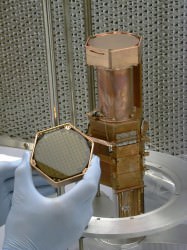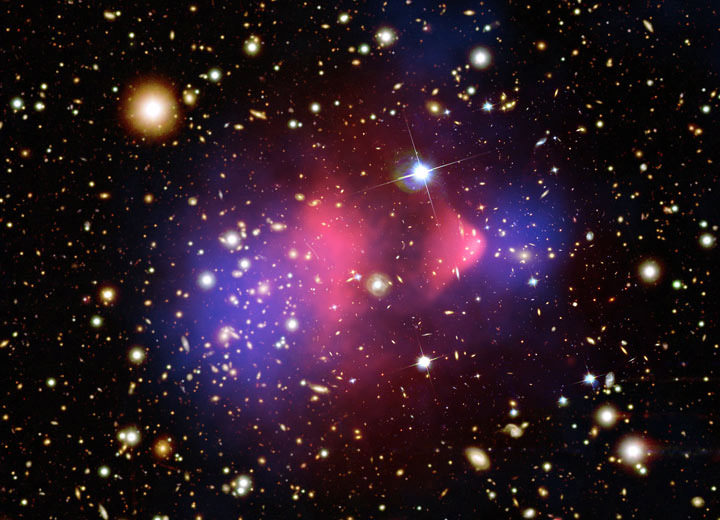Dark matter: it’s invisible, it’s elusive, it’s controversial… and it’s everywhere — in the Universe, yes, but especially in the world of astrophysics, where researchers have been exhaustively trying to reveal its true identity for decades.
Now, scientists with the international Super Cryogenic Dark Matter Search (SuperCDMS) experiment are reporting the detection of a particle that’s thought to make up dark matter: a weakly-interacting massive particle, or WIMP. According to a press release from Texas A&M University (whose high-energy physicist Rupak Mahapatra is a principal investigator in the experiment) SuperCDMS has identified a WIMP-like signal at the 3-sigma level, which indicates a 99.8 percent chance of an actual discovery — a “concrete hint,” as it’s being called.
“In high-energy physics, a discovery is only claimed at 5-sigma or better,” Mahapatra said. “So this is certainly very exciting, but not fully convincing by the standards. We just need more data to be sure. For now, we have to live with this tantalizing hint of one of the biggest puzzles of our time.”
If this is indeed a WIMP it will be the first time such a particle has been directly observed, lending more insight into what dark matter is… or isn’t.
Notoriously elusive, WIMPs rarely interact with normal matter and therefore are difficult to detect. Scientists believe they occasionally bounce off, or scatter like billiard balls from, atomic nuclei, leaving behind a small amount of energy capable of being tracked by detectors deep underground, particle colliders such as the Large Hadron Collider at CERN and even instruments in space like the Alpha Magnetic Spectrometer (AMS) mounted on the International Space Station.

The CDMS experiment, located a half-mile underground at the Soudan mine in northern Minnesota and managed by the United States Department of Energy’s Fermi National Accelerator Laboratory, has been searching for dark matter since 2003. The experiment uses very sophisticated detector technology and advanced analysis techniques to enable cryogenically cooled (almost absolute zero temperature at -460 degrees F) germanium and silicon targets to search for the rare recoil of dark matter particles.
This newly-announced detection actually comes from data acquired during an earlier phase of the experiment.
“This result is from data taken a few years ago using silicon detectors manufactured at Stanford that are now defunct,” Mahapatra said. “Increased interest in the low mass WIMP region motivated us to complete the analysis of the silicon-detector exposure, which is less sensitive than germanium for WIMP masses above 15 giga-electronvolts [one GeVa is equal to a billion electron volts] but more sensitive for lower masses. The analysis resulted in three events, and the estimated background is 0.7 events.”
Although Mahapatra says the result is certainly encouraging and worthy of further investigation, he cautions it should not be considered a discovery just yet.
“We are only 99.8 percent sure, and we want to be 99.9999 percent sure,” Mahapatra said. “At 3-sigma, you have a hint of something. At 4-sigma, you have evidence. At 5-sigma, you have a discovery.”
“In medicine, you can say you are curing 99.8 percent of the cases, and that’s OK. When you say you’ve made a fundamental discovery in high-energy physics, you can’t be wrong.”
– Dr. Rupak Mahapatra, SuperCDMS principal investigator, Texas A&M University

The collaboration will continue to probe this WIMP sector using the SuperCDMS Soudan experiment’s operating germanium detectors and is considering using larger, more advanced 6-inch silicon detectors developed at the Texas A&M’s Department of Electrical Engineering in future experiments.
The team has detailed its results in a paper published in arXiv that eventually will appear in Physical Review Letters. Mahapatra will also announce the results today at 12 p.m. CDT in a talk at the Mitchell Institute for Fundamental Physics and Astronomy.
Source: Texas A&M University


It might be even different particles.
It sounds like they’re barking up the right tree, if my knowledge of masses is still relevant in this day and age at least.
I’ve only one thing to say: It’s about bloody time! 😛
This is a light WIMP at 10 GeV. This is interesting, for it is likely too massive for axions and too light for the neutralino in supersymmetry. This is unless those 1970 models of light SUSY partners turns out to be correct, at least for the supersymmetric partner of the photon, W, and Higgs particle. The neutralino is a condensate state of these.
It is interesting that dark matter is considered to not interact with oridinary matter. Yet these DM particles somehow “ping” the Ge nuclei in the Si detector. This means there must be some type of interaction. This is not just a matter of something like two billiard balls smacking into each other.
LC
I naively assumed DM elastic scattering against nuclei was sufficiently analogous to neutrino scattering.
“On the other hand, Z boson interactions involving neutrinos have distinctive signatures: They provide the only known mechanism for elastic scattering of neutrinos in matter; neutrinos are almost as likely to scatter elastically (via Z boson exchange) as inelastically (via W boson exchange).”
[ http://en.wikipedia.org/wiki/Neutral_current ]
Weak neutral currents are often cited as a standard mechanism for such interactions. If so then these DM particles are not exactly dark, or are dark in the same way the neutrinos are dark. This would be the case for neutralinos, maybe for hidden or “exotic” quarks. It certainly would not be the case for sterile neutrinos and not for a lot of models with axions.
It might be that we have opened the door a crack into the DM world. It will be interesting to see if DM consists of a single form, say supersymmetric partners and predominantly neutralinos, or whether there is a multiplicity of sources, SUSY, axions, sterile neutrinos, dark quarks etc.
LC
Thanks for a nice overview of the zoo of potentials out there!
The universe is fricasseed.
Where’s the kaboom? There was supposed to be an earth-shattering kaboom!
I guess Germanium is used because of its high reactivity to the WIMP?
Since DM mass is unknown, spurious bumps are more easily confused for the real deal , which is why the usual 5 sigma for so called “look-elsewhere” in particle physics is used. And in particle physics 2-3 sigma results come and go the whole time. IIRC the Fermi-LAT DM galactic core bump was 4 sigma once, but with more data it has started to go away.
But the real problem for these underground data is that astrophysicists managed to set a great deal larger lower bound for any kind of DM in 2011, twice over:
“”What we find is if a particle’s mass is less than 40 GeV, then it cannot be the dark matter particle,” Koushiappas said.
The observational measurements are important because they cast doubt on recent results from dark matter collaborations that have reported detecting the elusive particle in underground experiments. Those collaborations – DAMA/LIBRA, CoGeNT and CRESST – say they found dark matter with masses ranging from 7 to 12 GeV, less than the limit determined by the Brown physicists.
“If for the sake of argument a dark matter particle’s mass is less than 40 GeV, it means the amount of dark matter in the universe today would be so much that the universe would not be expanding at the accelerated rate we observe,” Koushiappas said, referring to the 2011 Nobel prize in physics that was awarded for the discovery that the expansion of the universe is accelerating.
Independently, the Fermi-LAT collaboration arrived at similar results, using a different methodology. The Brown and Fermi-LAT collaboration papers will be published in the same issue of Physical Review Letters.”
[ http://phys.org/news/2011-11-physicists-strongest-limit-mass-dark.html ]
God says…
24:8 Take heed in the plague of leprosy, that thou observe diligently,
and do according to all that the priests the Levites shall teach you:
as I commanded them, so ye shall observe to do.
24:9 Remember what the LORD thy God did unto Miriam by the way, after
that ye were come forth out of Egypt.
24:10 When thou dost lend thy brother any thing, thou shalt not go
into his house to fetch his pledge.
Why are you quoting bible passages..?
This is completely irrelevant…not to mention confusing. So Terrance, just what is your point?
More like “where is his point?” I’d guess the top of his head.
Creationists shouldn’t comment on science. It is hilarious and makes deconverts from religion, see Dawkins’s Convert’s Corner.
And the LORD did grin and the people did feast upon the lambs and sloths and carp and anchovies and orangutans and breakfast cereals, and fruit bats and …
What does this even remotely have to do with this topic? I can come up with at least 2 passages off the top of my head that one could tie to this topic if one were willing to REALLY stretch the English translation.
Is there a point you are trying to make or doth thou merely trollith?
Dude, seek help SOON.
i think i get what the relevance, for a believer, is. But maybe you would like to elaborate so that others are not putting words in your mouth.
darkmattersalotdotcom:)
for a much more indepth study
http://vixra.org/pdf/1303.0207v1.pdf
What is Dark Matter?
This 4 page conceptual vixra article conjectures
that, more energetic than the cosmic gamma photons, there should exist dark
photons and Planck photons. Dark photons may be the particles of the elusive
dark matter.